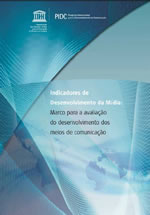UNESCO’s Media Development Indicators at the Brazilian House of Representatives
05-07-2010 (Brasilia)

Cover of the publication
© UNESCO
The Commissions for Minorities and Human Rights and Participatory Legislation of the House of Representatives of Brazil held a public hearing on June 23th, to launch and debate the Portuguese version of UNESCO’s "Media Development Indicators".
The public hearing program, chaired by Congresswoman Iriny Lopes, included presentations by senior officials, congressmen and women, researchers, and representatives of the Brazilian Association of Broadcasting (ABRA) and civil society organizations.
Participants welcomed the Media Development Indicators, endorsed in 2008 by UNESCO’s International Programme for the Development of Communication (IPDC) as a unique diagnostic tool for assessing the media system at national level. They urged Brazilian authorities to take them into account, especially during discussions on the new regulatory framework for media.
By introducing these indicators in the national debate in Brazil, UNESCO hopes to help integrate the country into the international media development agenda, and encourage it to implement actions that promote the free flow of ideas, which is an important part of the Organization’s mandate.
UNESCO’s Media Development Indicators offer a comprehensive view of the media landscape of a given country, focusing on five major interrelated categories: a) Legal and regulatory framework; b) Plurality and diversity of media; c) Media as a platform for democratic discourse; d) Professional capacity building; and e) Infrastructural capacity.
They are the result of an international consultation process involving specialists and media organizations from all regions of the world in an effort to ensure that the diversity and complexity of the media industry around the world be adequately reflected in the document.
The Media Development Indicators now exist in eight languages. The Portuguese version, translated with the support of Ford Foundation, is available for download on the UNESCO website.
The public hearing was recorded and can be watched here.
Participants welcomed the Media Development Indicators, endorsed in 2008 by UNESCO’s International Programme for the Development of Communication (IPDC) as a unique diagnostic tool for assessing the media system at national level. They urged Brazilian authorities to take them into account, especially during discussions on the new regulatory framework for media.
By introducing these indicators in the national debate in Brazil, UNESCO hopes to help integrate the country into the international media development agenda, and encourage it to implement actions that promote the free flow of ideas, which is an important part of the Organization’s mandate.
UNESCO’s Media Development Indicators offer a comprehensive view of the media landscape of a given country, focusing on five major interrelated categories: a) Legal and regulatory framework; b) Plurality and diversity of media; c) Media as a platform for democratic discourse; d) Professional capacity building; and e) Infrastructural capacity.
They are the result of an international consultation process involving specialists and media organizations from all regions of the world in an effort to ensure that the diversity and complexity of the media industry around the world be adequately reflected in the document.
The Media Development Indicators now exist in eight languages. The Portuguese version, translated with the support of Ford Foundation, is available for download on the UNESCO website.
The public hearing was recorded and can be watched here.
Related themes/countries
· Brazil
· Media Development
· International Programme for the Development of Communication (IPDC)
· Weekly newsletter
Share this story:
Contact information
- UNESCO
Source














